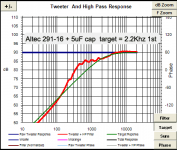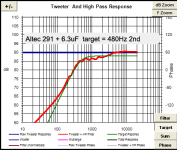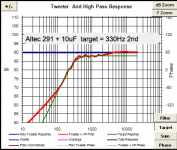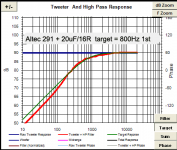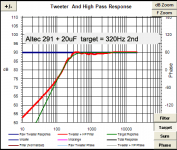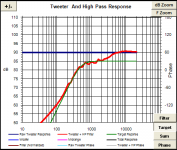I'm not at my PC where I have various speaker software... I will be home briefly later and pickup some parts.
I'm looking for a high pass filter to protect vintage Altec Lansing 299-16A compression drivers mounted on huge horns.
My first guess is a ~ 20uF cap. Just need something basic that will protect these from blowing without being too detrimental to the sound...
I'm helping out an art school graduate student who'll be using these for sound in an "installation"...
I'm looking for a high pass filter to protect vintage Altec Lansing 299-16A compression drivers mounted on huge horns.
My first guess is a ~ 20uF cap. Just need something basic that will protect these from blowing without being too detrimental to the sound...
I'm helping out an art school graduate student who'll be using these for sound in an "installation"...
20uF should be just fine. That's a 1st order at about 500Hz. You don't want to hit it too hard with just the cap, but it will offer protection, for sure. If you are using some other crossover, remember to add in this filter. Should give you approx a 3rd order acoustic at 500Hz.
Well - he was running them with NO protection off his Sony receiver and said they were REALLY loud, then the voice coils blew.
The 20uF should give them WAY more protection than just feeding them full range, eh? 🙂
I'm just wondering what kind of bump I'll see at FS, might need a notch filter - or, maybe just adding an ~ 8 Ohm shunt resistor after the cap will suffice. Don't have time for any software modeling for the next week or two with finals coming up...
The 20uF should give them WAY more protection than just feeding them full range, eh? 🙂
I'm just wondering what kind of bump I'll see at FS, might need a notch filter - or, maybe just adding an ~ 8 Ohm shunt resistor after the cap will suffice. Don't have time for any software modeling for the next week or two with finals coming up...
Well - he was running them with NO protection off his Sony receiver..........
..........maybe just adding an ~ 8 Ohm shunt resistor..........
Assuming an expo horn, then choose a cap based on 1/2 the horn's Fc, so for a 16 ohm driver on a 500 Hz horn choose a cap for a 250 Hz 1st order XO = 40 uF.
As a rule-of-thumb for a very low output impedance, using a matching damping resistor is desirable, or 16 ohms in parallel with the cap in this case.
GM
Sadly, not the capacitor part. 🙁 In my haste I responded from rote, i.e. assumed a distributed 70 V line sound system. For NO protection, i.e. 1st order XO, choose based on 4x Fc or 5 uF for a 500 Hz expo horn since we want the driver down -24 dB/125 Hz.
GM
GM
That seems high.... But it will keep him out of trouble, for sure.
Also think the parallel resistor is a good idea.
Also think the parallel resistor is a good idea.
Anyone looked at what replacement diaphragms cost for these drivers? I'm assuming that relatively inexpensive modern drivers could fit the bill, and these expensive vintage drivers could be put on eBay as is and easily pay for a modern replacement driver.
Unfortunately here ignorance is not bliss - an expensive mistake for sure.
Data sheet here: http://www.altecpro.com/pdfs/vintage/SpeakerAndMics/drivers/299-8A 299-16A HF Driver.pdf
Diaphragm Data Here: http://www.altecpro.com/pdfs/vintag...ers/HF Driver Cross Reference MASTER LIST.pdf
Great Plains Audio for replacement diaphragms: http://www.greatplainsaudio.com/parts.html
Note that the Pascalite diaphragms originally used in these drivers are not generally readily available.. (No longer made apparently by anyone.)
Here is what is currently available on eBay, probably cheapest option, and it might be OK: http://cgi.ebay.com/ws/eBayISAPI.dl...42430&_sacat=See-All-Categories&_fvi=1&_rdc=1 I can't vouch for the quality but for $110 for a pair as compared to the genuine item at maybe 4X - 5X this cost, it's reasonable.
Unfortunately here ignorance is not bliss - an expensive mistake for sure.
Data sheet here: http://www.altecpro.com/pdfs/vintage/SpeakerAndMics/drivers/299-8A 299-16A HF Driver.pdf
Diaphragm Data Here: http://www.altecpro.com/pdfs/vintag...ers/HF Driver Cross Reference MASTER LIST.pdf
Great Plains Audio for replacement diaphragms: http://www.greatplainsaudio.com/parts.html
Note that the Pascalite diaphragms originally used in these drivers are not generally readily available.. (No longer made apparently by anyone.)
Here is what is currently available on eBay, probably cheapest option, and it might be OK: http://cgi.ebay.com/ws/eBayISAPI.dl...42430&_sacat=See-All-Categories&_fvi=1&_rdc=1 I can't vouch for the quality but for $110 for a pair as compared to the genuine item at maybe 4X - 5X this cost, it's reasonable.
Last edited:
Yep, frams are not cheap. Even the knock-offs.
I was interested in what a single cap might do and also cap+resistor, so I ran a few graphs based on the impedance curve of an Altec 291-16K on a 300Hz horn.
You'll see various values and the nearest target slope. Remember, this is electrical, not acoustical. Some values make a nice shelf.
I was interested in what a single cap might do and also cap+resistor, so I ran a few graphs based on the impedance curve of an Altec 291-16K on a 300Hz horn.
You'll see various values and the nearest target slope. Remember, this is electrical, not acoustical. Some values make a nice shelf.
Attachments
An expo compression horn is a 2nd order acoustical hi-pass system and to get excellent power handling requires another 2nd order electrical system to adequately protect it, so it's considered an acoustical 4th order system. Now ideally we want the driver 100% protected, but this would mean an XO point well above its gain BW that requires a cap with too small a power rating, so as a practical trade-off, a -24 dB point was long ago deemed an acceptable point of diminishing returns. Since a 1st order has a 6 dB octave slope, it must be 4x higher then to reach it with the understanding that it won't protect the driver hardly at all below this point, so if it 'feels' any high power (mid) bass it might still be blown if no damping resistor is used.
GM
Ah! I see you've ~worked it out since I saw your initial response, though I still recommend the 4 uF and if more damping is required, then increase the resistor value and why I typically use a cheap 25 ohm pot to dial it in, then replace it with a fixed resistor network.
GM
Ah! I see you've ~worked it out since I saw your initial response, though I still recommend the 4 uF and if more damping is required, then increase the resistor value and why I typically use a cheap 25 ohm pot to dial it in, then replace it with a fixed resistor network.
Last edited:
If you are suing some other crossover
All these legal issues nowadays. Sheesh.
Ha! My spelling checker should be suing me for misuse! Y kant id ficks mie tiepoz?
Anyhow. Thought I'd give the solo 4uF cap a whirl - been listening to it for a couple of hours. Have to say it sounds rather nice. 500Hz LR low pass on the woofer. Since I use so little power, no fear of hurting the fram.
Anyhow. Thought I'd give the solo 4uF cap a whirl - been listening to it for a couple of hours. Have to say it sounds rather nice. 500Hz LR low pass on the woofer. Since I use so little power, no fear of hurting the fram.
So, it's not until the cap size starts to approach/go over 20uF that a shunt cap is needed to bring down the bump at FS, it appears...
I guess I'll go with 11uF - 10uF electrolytic "bypassed" by a good 200v metalized poly 1uF cap.
I think I'll go ahead and put in a 20 Ohm shunt resistor, still don't have time to do any modeling yet though.
I guess I'll go with 11uF - 10uF electrolytic "bypassed" by a good 200v metalized poly 1uF cap.
I think I'll go ahead and put in a 20 Ohm shunt resistor, still don't have time to do any modeling yet though.
Last edited:
Oh - 4uF I see people recommending now - hmm. He was playing the horns unprotected and full range when they blew... Any more recommendations on the value of the shunt resistor?
Eh? You really think so? I would have thought it'd be well protected below 500 Hz if you use < 5uF + a shunt cap?...with the understanding that it won't protect the driver hardly at all below this point...
Last edited:
As I noted, -24 dB is a practical trade-off when using a 1st order XO, but for 'full-range' high power apps it jumps to > -35 dB referenced to a 2nd order XO's protection...........
GM
GM
Well as far as I can tell, the 4uF cap is within 1 dB of a normal 2nd order 500Hz filter at the -24dB point. Simulates, measures and sounds the same here.
But putting i a shunt resistor in changes.
For the moment I'm running 10uF and 11mH +L-Pad. Works really well. I do need to drop down to about 7mH, but the big coil was what I had on hand. Still, the single small cap worked well.
What do you think, GM?
But putting i a shunt resistor in changes.
For the moment I'm running 10uF and 11mH +L-Pad. Works really well. I do need to drop down to about 7mH, but the big coil was what I had on hand. Still, the single small cap worked well.
What do you think, GM?
Well as far as I can tell, the 4uF cap is within 1 dB of a normal 2nd order 500Hz filter at the -24dB point. Simulates, measures and sounds the same here.
But putting i a shunt resistor in changes.
For the moment I'm running 10uF and 11mH +L-Pad. Works really well. I do need to drop down to about 7mH, but the big coil was what I had on hand. Still, the single small cap worked well.
What do you think, GM?
True and why the -24 dB point was chosen as the acceptable 'gamble', but below this point the the 2nd order is rolling off twice as fast...........
Can't really comment much about what's best for large format drivers in individual apps since most of my tweaking experience is limited to either using ~matching impedance amps or ones with variable DF (bass tone control) or various ways to implement R/C networks to mimic these in SS amp apps.
I mean the prosound guys typically wanted ~flat to ~12.5 kHz and the HIFI guys to ~16 kHz which WRT the former sounded too dull and the latter too fatiguing to mine and some others (especially female) ears, so quickly replaced them in my system. If I were to use them today I'd probably limit them to ~1 WL of its individual cell acoustic mouth area and certainly no more than 5 octaves above its design cut-off same as is done with at least some of the large multi-horn cinema sound apps these days.
GM
Oh, I've got some ~9mH iron core inductors that I could give him - should I use 11uF + the 9mH + 20 Ohm shunts? Ugh - I've got a programming lab due in 1/2 hour that I still have to START!!! Doh...
- Status
- Not open for further replies.
- Home
- Loudspeakers
- Multi-Way
- HP filter for Altec Lansing 299-16A?
